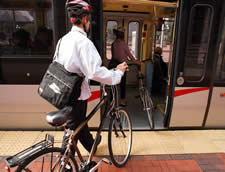Routes to Rail Stations
 Since 2003, the North Central Texas Council of Governments (NCTCOG) has coordinated with local communities and transportation agencies to study active transportation (walking and bicycling) routes to light rail and commuter rail stations across the Dallas-Fort Worth (DFW) region. The regional passenger rail network includes Dallas Area Rapid Transit (DART), Trinity Metro, and Denton County Transportation Authority (DCTA) with stations located in 13 cities across four counties.
Since 2003, the North Central Texas Council of Governments (NCTCOG) has coordinated with local communities and transportation agencies to study active transportation (walking and bicycling) routes to light rail and commuter rail stations across the Dallas-Fort Worth (DFW) region. The regional passenger rail network includes Dallas Area Rapid Transit (DART), Trinity Metro, and Denton County Transportation Authority (DCTA) with stations located in 13 cities across four counties.
Various Active Transportation Routes to Rail Station studies reviewed the following within one-half mile radius around each rail station:
- Existing pedestrian facilities and gaps in the pedestrian network
- Existing and planned bicycle facilities
The purpose of these studies is to provide a resource for cities, transit agencies, property owners, and individuals to understand the active transportation options (walking and bicycling) as well as the gaps in the existing active transportation network to reach each passenger rail station in the DFW region. Further, the studies outline a framework for future investments in infrastructure needed to improve walking and bicycling access to these stations.
2024 Silver Line Routes to Rail Stations Study analyzed pedestrian routes around seven Silver Line rail stations in Addison, Carrollton, Dallas, Plano and Richardson.
2023 DCTA A-Train Routes to Rail Stations Study analyzed pedestrian routes around six DCTA A-Train commuter rail stations in Denton, Lewisville, and Carrollton.
2020 Federal Transit Administration Planning Pilot Grant included an analysis of pedestrian routes around 28 DART stations along the system’s Blue and Red lines in Dallas, Garland, Richardson, and Plano. An assessment of streets, sidewalks, and other routes connecting the light rail stations examined infrastructure needed to improve pedestrian access. The study included detailed evaluations of pedestrian infrastructure needs for corridors within a one-half mile radius of the DART facilities, wherein improvements were identified and ranked as High, Medium, and Low, based on the potential benefit to improve active user access to and from the stations. The study includes an Opinion of Probable Construction Costs for recommended infrastructure improvements and final reports for each city within the study area.
Staff contact: Kevin Kokes
